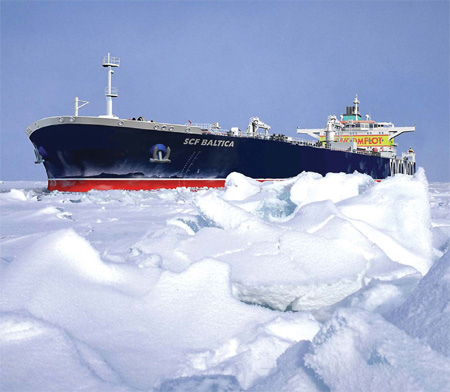-
News >World
First Russian gas tanker forges passage to China
2010-08-26 07:39MOSCOW - A Russian gas tanker is this month making a historic voyage across the famed Northeast passage as receding ice opens up an elusive trade route from Asia to the West sought for centuries by explorers.

Russia's tanker Baltica sails during a voyage along the Northern Sea. Morskoi Flot Magazine / Agence France-PresseThe 114,564-ton tanker Baltica, escorted by the world's two most powerful nuclear ice breakers, sailed from Russia's northernmost port of Murmansk on Aug 14.
The largest vessel to ever navigate once-impassable route, the Baltica is due to deliver its cargo of gas condensate to China in the first weeks of September.
Russian television has shown the tanker making cautious progress through chunky sheets of ice in the wake of the steel-rimmed ice breakers, as a polar bear loped across ice floes within shouting distance of the ships.
"Never before has a ship of this size passed via the Northeast sea passage," Captain Alexander Nikiforov said in an interview with Russian channel NTV.
The trailblazing voyage by Russian state-owned shipping giant Sovcomflot is the latest Kremlin bid to mark out its stake over the energy-rich Arctic, where retreating ice cover amid global warming is opening new strategic trade routes.
Russia hopes to make the Arctic route a competitor to the Suez Canal and increase cargo traffic along its Siberian coast from two million tons a year now to 30 million tons - profiting off taxes and the lease of its unique fleet of nuclear ice breakers.
The Northeast passage is tens of thousands of kilometers shorter than existing routes, stretching 13,000 km along Russian shores to Asia compared to the 22,000-km passage via the Suez Canal, Sovcomflot said.
"The aim of the voyage is to determine the feasibility of delivering energy on a regular, economically viable and safe basis along the Northern Sea Route from the Barents and Kara Seas to the markets of Southeast Asia," Sovcomflot said in a statement.
But mariners admit many obstacles remain before Russia's shipping route might steal business from established southern thoroughfares - not least because of a summer that lasts just a few weeks.
Sovcomflot said it must find new deep-water routes to steer heavy tankers through the perilous coastal waters and contend with free-floating icebergs that make the route hard to time and unreliable.
"The summer in Arctic waters lasts two to two and a half months. It's winter the rest of the time," chief engineer Boris Abakhov told NTV.
As the tanker neared the most precarious stretch of its journey - via the Vilkitsky Strait, leading around Siberia's northernmost tip - mariners floated a wreath in memory of sailors who died in the icy waters, the television showed.
The shallow, ice-choked strait, named after Russian explorer Boris Vilkitsky who mapped it in 1913, separates the Kara Sea from the Laptev Sea about halfway along the Siberian coastline.
In 1553, the British adventurer Sir Hugh Willoughby perished with his crew in the Arctic waters on an expedition to discover a northern route to China. While Russia has long shipped small cargo along its sprawling Arctic shores, two German cargo ships made the first commercial trip last summer from South Korea to the Netherlands even as United Nations Secretary General Ban Ki-moon warned the Arctic may be ice-less as soon as 2037.
Since a Russian expedition planted a flag at the North Pole in 2007, the five Arctic nations - Russia, the United States, Norway, Denmark and Canada - have grown more vocal in their competing claims over swaths of the energy-rich territory.
